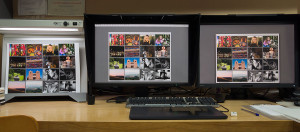The PG2401PT promises high end performance for modest money. Does it deliver?

A brief review:
Being a new name when it comes to colour critical professional monitors the BenQ PG2401PT finds itself up against the market leading models from the NEC Spectraview and Eizo CG ranges. I was intrigued when I read the impressive specs and price of the new BenQ Pro Graphics monitor and wanted to see how it fared against our long trusted Spectraview Reference screens.
The very comprehensive features of the BenQ PG2401PT include:
- 24.1″ 1920×1200 (16:10) LCD
- GB-r-LED backlight
- AH-IPS wide gamut panel
- 99% Adobe RGB coverage/100% sRGB/104% NTSC
- 10bit capable (8bit+FRC)
- Hardware programmable 14bit 3D LUT
- Brightness Uniformity Correction
- Print industry certified (G7/Fogra)
- DVI, HDMI, DisplayPort, Mini DisplayPort
- 2 x USB 3.0 inputs
- Monitor hood
- 8 in 1 Multi Card reader (including SD/SDHC/SDXC)
- Auto detection of landscape and portrait modes
- Anti-glare coating
Quite the list, I am sure you’ll agree, which goes on but I have highlighted the ones most relevant from a professional imaging and print output viewpoint.
The 1920×1200 pixel panel is a current generation AH-IPS unit with a specified viewing angle of 178 degrees. In comparison to our NEC Spectraview Reference 241’s previous generation P-IPS panel, the viewing angles are slightly less in the PG2401, but is still nonetheless very good. Interestingly this aspect of the BenQ is similar to the current NEC SR242 which is also a GB-r-LED IPS panel. The LED backlight uses a GB-r formulation which offers the benefits of low energy, low heat, reaching operating white point instantly (without the warm up needed for older CCFL backlighting), and enables accurate wide gamut performance unlike the White LED array commonly found in most low cost LED monitors.
Once I set up the PG2401 next to our NEC SR 241, I installed the BenQ/Xrite Palette Master calibration software to profile and evaluate performance. This program is based on the excellent Xrite i1Profiler colour engine and seems written to exclusively recognise the BenQ monitor, so if it does not detect it on the system will tell you so when the program starts up. After calibrating using the same settings as our NEC, to best suit our studio lighting condition, I opened a test montage image on each monitor and placed an accompanying print under a GTi D50 viewing booth. The results are of very high quality and I have no reservations using the BenQ monitor as a reliable soft proofing device and certainly am happy to recommend it for professional use.
There is also the bonus of reduced energy usage resulting from being able to allow a shorter time for monitor sleep mode to engage, knowing there is no time penalty waiting for it to be ready to work again, along with lower overall power consumption doing its bit to help make our world is little greener! To add to that, the box size (and therefore the materials, weight and transportation) is minimised due to the base being packed flat, but because of the clever design, the monitor can be assembled in a minute or two, even without referring to instructions.
So, does this modestly priced BenQ Pro Graphics monitor deliver on performance? That is a definite yes. Along with all the rich features which includes a monitor hood and USB 3.0 hub (a very welcome surprise), this sturdy and well designed new Pro Graphics monitor from BenQ is impressive.
We now have a BenQ PG2401PT in our showroom studio which you can come in and see if you are in the Central London area, and until the end of February you can get a bundled Xrite i1 Display Pro for a reduced price. Why not pop in and take a look for yourself?

